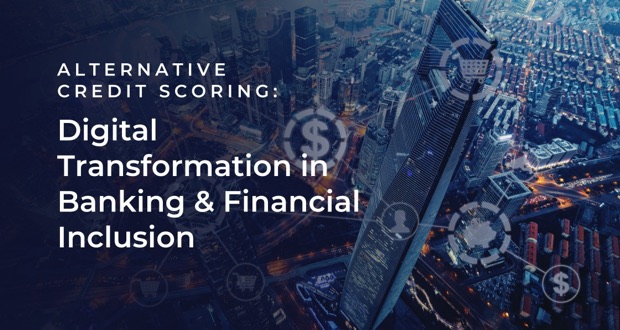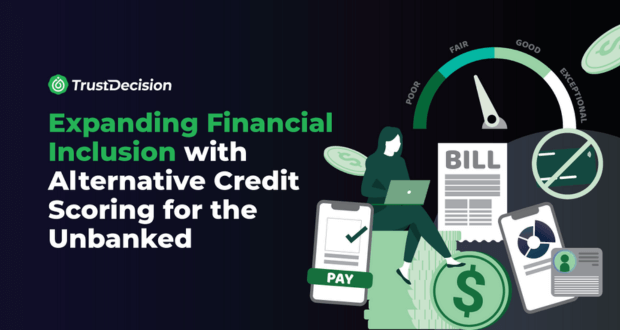Alternative credit scoring is making waves in the digital transformation in banking. It’s a revolutionary approach reshaping how financial institutions assess creditworthiness, helping credit or lending companies, primarily banks, mitigate losses with a robust assessment of borrowers’ credit risk. Alternative credit scoring is made possible by the remarkable surge in digital consumption and the widespread digitization of financial systems.
As smartphones and internet usage become more widespread, they leave behind valuable digital footprints, paving the way for a groundbreaking approach to credit assessment. The broader digitization, highlighted by the growth of micro-financing through online lending, Buy Now Pay Later (BNPL) platforms, e-wallets, telco services, and messaging apps, is not just altering how financial transactions take place—it's unlocking a wealth of accessible data unprecedented in scale.
This article delves into the world of digital transformation in banking, focusing on alternative credit scoring, its objectives, AI and regulatory frameworks’ pivotal role in financial inclusion.
Traditional Credit Scoring
Traditional credit scoring relies on a limited set of variables, such as credit histories, transactions, and loan repayment, often excluding individuals with no credit history. The coverage becomes even more restrictive in countries with high unbanked or underbanked populations. For instance, over 70% of Southeast Asia’s population is unbanked or underbanked, where top countries contributed to the percentage include Vietnam (79%), the Philippines (78%), and Indonesia (77%) (source: National Geographic).
What is Alternative Credit Scoring?
Alternative credit scoring is a paradigm shift from traditional methods.
It broadens the scope by incorporating diverse data sources beyond income and credit history, namely
- utility payments
- e-wallet transactions
- e-commerce activity
- social media profiles
- e-wallet
- SIM card or messaging app status
- device data
- location matching
Leveraging these unconventional data sources to evaluate an individual’s or business’ creditworthiness, it also provides a security net for fraud risks. By embracing alternative credit scoring, the aim is to empower those excluded from traditional banking systems, providing them access to loans and financial services. It strives to achieve financial inclusion and digitization of the unbanked. This shift allows for a more comprehensive evaluation, ensuring a fair assessment of creditworthiness.
Staying Competitive With Alternative Credit Scoring
All types of financial institutions, be it banks, peer-to-peer (P2P) lending or any digital platforms with microfinancing capacity, including BNPL, can benefit from a robust credit scoring model. What’s more, it offers better visibility to avoid loan stacking. Here are the advantages of alternative credit scoring that give financial institutions a competitive edge.
1. Making the Invisible Visible
Addressing the unbanked issue is at the core of alternative credit scoring. With new alternative data, previously overlooked individuals are now visible in the credit ecosystem. This means:
- Enter into the untapped market, thus expanding their customer base.
- Increase the creditworthiness accuracy of each applicant to keep losses at bay.
- Comprehensive customer profiles facilitating tailored services beyond lending, such as personalized banking products.
2. Automation Beyond Speeding Up Processes
AI fundamentally transforms the accuracy and efficiency of decision-making—smarter, more accurate, and more efficient. These technologies streamline decision-making, reducing processing times and improving overall effectiveness. Here’s how:
- Enhanced Accuracy: Alternative data allows automated systems to consider a broader spectrum of factors when assessing credit risk. This results in a more accurate depiction of an individual's financial behavior, reducing the likelihood of overlooking creditworthy applicants.
- Streamlined Decision-Making: Automation streamlines the decision-making process, enabling financial institutions to process a higher volume of loan applications without sacrificing accuracy. This efficiency is crucial in meeting the demands of today's fast-paced digital economy.
- Adaptability to Changing Circumstances: Machine learning algorithms, a key component of AI, continuously learn and adapt to changing market conditions and consumer behavior. This adaptability ensures that credit risk assessments remain dynamic and responsive to evolving economic landscapes.
- Risk Mitigation: By leveraging alternative data, automated systems can identify patterns and trends that traditional models might overlook. This proactive approach allows for the early identification of potential credit risks, reducing the overall risk to the credit portfolio.
- Operational Efficiency: Automation reduces manual intervention, minimizing the chances of errors and speeding up the entire loan decisioning process. This improves efficiency and frees up valuable resources for more strategic tasks.
3. Financial Inclusion
Alternative data contributes to financial inclusion by providing opportunities for individuals with limited or no traditional credit history.
- Reaching the unbanked population
- Empowering new entrants to the credit system
- Mitigating biases in traditional scoring
- Encouraging financial institutions to serve a diverse customer base
- Enabling microfinance and P2P lending
- Supporting economic development
This actively works towards creating a more equitable and accessible financial landscape, ensuring that a broader spectrum of individuals can participate in and benefit from the formal financial system.
Challenges & Risk Factors of Alternative Credit Scoring
There are always two sides to everything. Having explored the myriad advantages of alternative credit scoring, we now focus on the intricate challenges and risk factors accompanying this transformative journey.
1. Data Privacy and Security Concerns
As alternative credit scoring relies heavily on diverse data sources, ensuring the privacy and security of this information becomes paramount. Stricter data protection regulations, such as the GDPR in Europe, demand meticulous attention to how personal data is collected, stored, and utilized. Instituting robust encryption measures and secure data storage protocols is a regulatory requirement and crucial for building and maintaining trust with consumers.
2. Regulatory Challenges in Consumer Credit Scoring
Embarking on the journey of alternative credit scoring introduces financial institutions to a complex regulatory landscape—where innovation must harmonize with stringent compliance requirements. The evolving nature of technology often outpaces existing regulations, leading to a delicate balancing act that institutions must master. Regulatory bodies tasked with safeguarding consumer rights and financial stability grapple with the rapid advancements in alternative credit scoring methodologies. The challenge lies not only in updating existing regulations to accommodate these innovations but also in anticipating potential risks and mitigating them proactively.
Often, the regulatory challenges include:
- Navigating Jurisdictional Variances: Financial institutions face a key challenge in dealing with different rules across regions. Each area has its own laws for credit scoring, making it tough for global businesses. To handle this, companies need to be careful, following local laws while also sticking to an overall global strategy.
- Transparent and Explainable Algorithms: Regulations require clear explanations for how credit scoring models work. Financial institutions must develop algorithms that are easy to understand for both regulators and consumers to meet these transparency requirements.
- Ensuring Fairness and Non-Discrimination: Regulators want to make sure credit scoring is fair and not biased. When using new data sources, like unconventional ones, there's a worry about biases. To address this, institutions need to regularly check for biases in their algorithms and use techniques that prioritize fairness in machine learning.
3. Embedded Bias in AI/ML Systems
AI and machine learning (ML) in alternative credit scoring bring exciting advancements but also pose ethical challenges. Recognizing and addressing biases in these systems is crucial for trust and fairness.
Here are the key concerns:
- Ethical Quandary of Bias: Embedded bias, often unintentional, poses a significant threat to fair credit scoring. Historical data biases can lead to unfair outcomes. Recognizing and fixing these biases is essential for unbiased credit assessments.
- Explainability for Trust: AI algorithms can be unclear, creating trust issues. Achieving clarity in these systems is not just a rule; it's crucial for ethical AI. Financial institutions must prioritize models that are easy to understand, building confidence in the fairness of decision-making.
- Cybersecurity Challenges: As institutions move to digital credit scoring, protecting systems from cyber threats is vital. Ensuring data security is not just a tech need but an ethical duty to safeguard consumers and institutions.
- Impact on Financial Stability: The widespread use of AI/ML in credit scoring may impact financial stability. Unintended consequences like mass defaults due to errors need careful monitoring. Financial institutions must assess and manage these systems to prevent disruptions in the financial ecosystem.
Overcoming Challenges of Digital Transformation in Banking
Embracing digital transformation in banking presents hurdles, but proactive strategies can turn challenges into opportunities.
1. Data Management for Holistic Insights
Addressing challenges in data quality and diversity is crucial for a comprehensive understanding. Ensuring a holistic view through effective data management enhances the reliability of credit scoring models.
2. Proactive Engagement with Regulators
Proactively engaging with regulators ensures the scalability of credit scoring models to align with the latest regulations. This approach helps financial institutions stay ahead, fostering a harmonious relationship with regulatory bodies.
3. Bias Reduction through Continuous Monitoring
Implementing continuous monitoring, learning, and keeping data collection up to date are pivotal in reducing bias. This proactive stance contributes to the ongoing refinement of credit scoring models, promoting fairness and accuracy.
4. Flexible Infrastructure Solutions
Choosing a solution provider that offers flexible infrastructure options is key. There is an array of tools at their disposal to tailor their credit scoring approach. Whether opting for a generic score, customized score, joint modeling, or traditional score, flexibility ensures adaptability to evolving needs in the dynamic digital transformation landscape.
Generic Score: Off-the-shelf fraud score, credit score, and telco score
Customize Score: Solution provider's data and scoring for the client to create a combined strategy with the agreed features
Joint Modeling: A combination of solution provider's and client's data to create a credit scoring model with the agreed features
Traditional Score: Solution provider to strategize credit scoring model solely based on client's data with the agreed features
Conclusion
The journey of digital transformation in banking through alternative credit scoring is just the beginning. As financial institutions continue to innovate, collaborate, and address challenges, the future holds a promise of increased financial inclusion and a more resilient, efficient, and equitable banking ecosystem. TrustDecision aims to be part of the equation in helping financial institutions embrace the transformation. With technological innovation that centres around people, together we can transform lives and shape the future of finance.






%2520(1).png)






